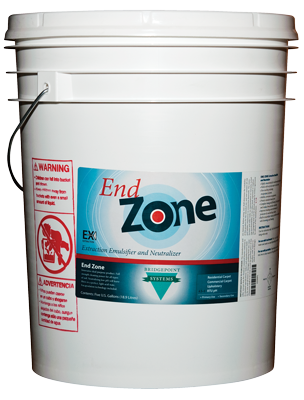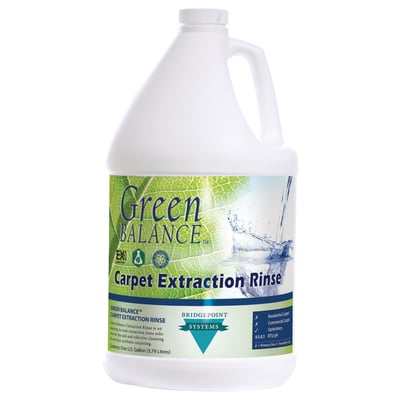The main goal of rinsing is generally understood to be flushing away residues of cleaning agents. It seems intuitive to rinse with clear water and not add anything when you are trying to remove residue.
Is that really the case? Do your rinse agents serve any purpose other than to flush away residues? Will an acid rinse in my solution line interfere with my prespray? Is a powdered rinse better than a liquid rinse? Those are the questions we will examine in this article. The answer might be more complex than you expect.
There are Multiple Roles of Rinse Products
Rinse products may be alkaline, acid, or neutral. Alkaline rinse products are commonly called emulsifiers. They add an extra boost of cleaning power and emulsify or hold in suspension oil and oily soils.
Your prespray contains detergents or ingredients that “make water wetter” by reducing the surface tension of the water. This allows the cleaning solution to form much smaller droplets and penetrate into smaller places like the spaces between individual fibers and even into scratches and abrasions on the fibers.
There may be more in your clear water rinse than you realize. Depending upon where you live and which water system you connect to, your rinse water may contain anywhere from less than three to over 15 grains of dissolved material in each gallon of water (Grain is a measure of weight familiar to those in water damage restoration). Water hardness alone is a source of residue in many areas.
Distilled water or water treated by a reverse osmosis procedure has almost no dissolved solids. It is “hungrier” to dissolve and remove whatever it can. Distilled or RO water is a better rinse than tap water, but there are better options. Water softened with a standard water softener does not have dissolved minerals but dissolved salt instead. This is good for reducing chemical usage but does not have a significant effect on rinsing.

The addition of a small amount of surfactant to reduce the surface tension of the rinse water allows your rinse to have the same small size as the particles of the prespray. The rinse can reach all the small nooks and crannies reached by your prespray. This will make the rinsing more complete. Remember that detergents and surfactants in a rinse will be diluted much more than in a prespray. A prespray may be 1:8 or 1:16 or even 1:32. When you put 32 ounces of a rinse product in your five gallon stock solution container, there is a 1:20 dilution. Depending upon where you set your meter, the final dilution may be 1:320 or even 1:400 as great as 1:600. This minute amount of surfactancy allows a thorough rinsing without adding much that needs to be extracted.
Besides assisting in flushing out soils and prespray, what other purposes can a rinse product offer?
1. As an example, think about cleaning a living room. Some of the smaller furniture has been moved out of the way, but the couch is still in place. That couch has been there since the last time the carpet was cleaned.
You prespray all the exposed carpet and it cleans up great. Now it’s time to clean under the sofa. It’s pretty dusty under there, but the soil has not been subjected to thousands of feet and shoe steps and is not deeply embedded. You could get your prespray back out, maybe disconnect your wand and hook-up the Hydro-Force in-line sprayer and go to work on the carpet that had been covered by the couch. But a small amount of cleaning punch provided by your alkaline emulsifier /rinse solution may be all that is required. You just saved at least 5 minutes.
2. What about cleaning the pivot point on the path from the kitchen to dad’s favorite recliner? It needs a little extra attention. Time for some scrub strokes. If there were no alkaline rinse products in your line, the first pass with the wand would have removed most of the prespray. But a bit of cleaner in the line means you are still cleaning as you make additional strokes.
Acid rinses have the advantage of neutralizing any alkaline detergent residues that remain in the carpet. This reduces resoiling. Any detergent left in the carpet continues to work or react with the soil. When active detergent residue is in the carpet, it "cleans" soil off the bottom of shoes and this soil is now on the carpet.
Many acid side rinse products leave the carpet feeling softer, a good selling point for residential clients. Some protectors also work better when applied to a carpet that is neutral or slightly acidic as compared to a highly alkaline fiber.
When Bridgepoint introduced End Zone cleaners could take advantage of a new opportunity, a HWE rinse that included an encapsulation polymer that discouraged wicking and resisted resoiling! Carpets could stay cleaner looking longer. A cleaning boost, neutralizing, and resoiling prevention in one product.
You have your in-line sprayer attached to your solution line dispensing your prespray onto a soiled carpet. The acidic rinse agent you selected is being metered into your solution line back at the van. Is this going to neutralize or adversely affect your prespray?
The short answer is “No.” But, you ask, “Isn’t the job of an acid rinse agent to neutralize prespray? If it doesn’t accomplish that, what is the point of using a rinse agent?”
What Interaction is there Between Presprays and Rinses?
A well-formulated prespray is commonly buffered or designed to maintain its alkalinity even under circumstances that might tend to lower the pH. (The exception would be prespray for use on wool or natural fibers.) Thus, the pH of a prespray will drop a relatively small amount when diluted with water; it is virtually unaffected when it encounters a little acidic rinse solution.
We discussed the dilution rate of rinse agents above. At 1:320 the amount of rinse solution being mixed with your cleaning solution is small that it has very little effect on the final pH or alkalinity of your prespray.
This short discussion may have saved you thousands of steps over the coming years. There is no need to turn off the flow from your rinse solution when you start to prespray and then hustle back to the van to turn the flow back on.

Should I use a Liquid or Powder Rinse?
Finally we get to the question of powdered rinses versus liquid rinses. Are there differences? Is one better than another?
Powders can be 100 percent (or nearly 100 percent) active ingredients. Liquids will include some water in which the raw materials are dissolved. Thus, powders have the potential to be more economical. You are not paying for water, although you could be paying for fillers. However, with dilution rates of 1:320, 1:500 or even greater, the savings will be rather small. Liquids are convenient because they can be easily measured and require no extra time to make sure that the powder is dissolved. Liquids also won’t clump up or get hard if they absorb moisture from humid surroundings.
As a general rule (yes, there are exceptions to the rule), powdered rinse products are alkaline emulsifiers. Why is that? Emulsifiers will contain alkaline builders. The choice to make an emulsifier a powder often stems from the raw materials available to perform well at a reasonable cost. The options for the formulator of an alkaline include several forms of phosphate and sodium which are powders. These powders can be corrosive or contribute to build-up on metal plumbing. A quality emulsifier will also include corrosion inhibitors.
What about powdered choices on the acid side? Citric acid is a powder but it is known for leaving a sticky residue, which isn’t really appropriate for a rinse product. Oxalic acid and sulfamic acid are also available as powders. But at 100% concentration, these are pretty potent and there is a possibility of damage to fibers or harm to technicians. If they are not used at full strength, what would be used to thin the product?
The job of making an acid side powdered rinse agent is pretty difficult, but not impossible, for the formulator. Powders can absorb a certain amount of liquid. Thus an alkaline powder may be mixed with a liquid acid to get a neutral or an acid side powder. But if one were to include too much liquid, the powder would clump.
Choose from our Selection of Rinses
Our lineup includes End Zone, our star for residential rinses. It neutralizes and rinses detergent residues, provides some cleaning boost, and includes anti-wicking, and anti-resoiling polymers.
We also have a near neutral (pH of 7.5) powdered emulsifier called Fiber Plus that is safe for all fibers including wool, cotton and other natural fibers in carpet, rugs, or upholstery.
Fiber Plus is 100% active ingredients and may be diluted 1:1000 or even 1:2000.
Power Point is a liquid alkaline suitable for everything from greasy restaurants to offices to homes.
Clean Free is a soap and detergent free rinse agent with no VOCs, no fragrances, no dyes, or other additives. It uses carbonation to help keep loosened soils in suspension during the rinse and extraction process.
We also have both alkaline and acidic liquid rinse products in our Green Balance products. They carry U.S. EPA Design for the Environment, Green Seal, and Green Balance certifications.
In our rug line, Wool Zone is specifically made for the needs of Oriental rugs as well as installed wool carpets.
by Scott Warington
